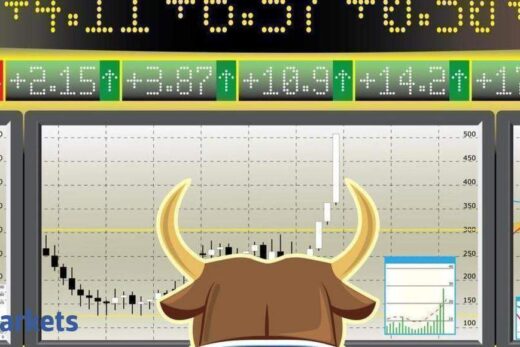Stakes are rising. Down almost 5% in September, the S&P 500 just had its worst month since the coronavirus landed. Quarterly guidance, which improved in the runup to the past four reporting periods, is now deteriorating. Analysts’ conviction in forecasts is hardening, potentially limiting upside surprises, with dispersion among high and low estimates suddenly narrowing from a decade-long high.
All this sets the stage for a particularly dramatic serving of results, with investors searching the corporate tea leaves for clarity on everything from the impact of rising rates and commodity inflation to broken supply chains.
At risk is a pattern of bullishness that has helped fuel the market’s doubling since March 2020: Stocks have risen every time results were being reported, a vote of confidence in profit margins. Now their uncanny durability faces its greatest threat at a time of increasing costs for companies.
 Bloomberg
Bloomberg“What we are going to be laser-focused on in this earnings season is pricing power,” said Giorgio Caputo, senior portfolio manager at J O Hambro Capital Management. “What we’re seeing is that getting the machine back up and running — those who thought it would be an easy quick fix are being disappointed now.”
Heading into the third-quarter reporting season that begins next week, analysts expected profits at S&P 500 firms to climb 28% to $49 a share, data compiled by Bloomberg Intelligence show. That’s down from an eye-popping clip of 94% in the previous quarter, marking the onset of a slowdown that has historically signaled weakening returns for stocks.
Corporate profits have been the major generator of stability in the coronavirus age. As the pandemic waxed and waned, companies consistently proved their resilience, beating analyst estimates by at least 15% for five quarters in a row.
Thanks to the robust results, reporting season has reliably been a boon for equity bulls. Since March 2020, the S&P 500 has risen each quarter, advancing 4% on average over the six-week stretch.
 Bloomberg
Bloomberg“Analysts have been chasing the actual performance for the past several quarters,” said Brad McMillan, chief investment officer at Commonwealth Financial Network. “And the question is really going to be — are analysts going to get it right this time, or are we going to see more outperformance?”
After being blindsided by the pandemic, Wall Street is acting like it has a better handle on the outlook of individual companies — a potentially bearish development if upside surprises have served as the main reason for the rally. Estimate dispersion, a measure tracked by Bank of America Corp., fell below the historic average in August after spiking last year to levels not seen since the aftermath of the 2008 global financial crisis.
Right now, earnings sentiment among analysts is souring. As supply chain bottlenecks and a shortage of workers prompted companies like FedEx Corp. and Nike Inc. to lower guidance, profit estimates fell in September.
To Deutsche Bank AG strategists including Binky Chadha, those blockbuster surprises are unlikely to repeat. He expects actual profits this time to come in around 6% above expectations, roughly in line with the historic norm.
“The macro backdrop is a little less supportive,” Chadha wrote in a recent note, citing a weaker-than-expected economy and a strong U.S. dollar that may hurt businesses overseas. And yet, “the market in our reading is priced for these large beats and upgrades to continue,” he said.
 Bloomberg
BloombergHow much earnings are priced in? Should the S&P 500’s price-earnings multiple go back to its five-year average of 18.8, that implies index-wide profits of $234 a share for the next 12 months. Analysts anticipated $214.
A rush to rein in costs has allowed companies to wring out more from sales. Profit margins, which have climbed to a record this year, are expected to improve in the next two years, analyst estimates show.
Equity bulls had better hope these projections stay intact. According to a study by Gina Martin Adams, chief equity strategist at Bloomberg Intelligence, a peak in margin forecasts foreshadowed four of the S&P 500’s largest routs in the last decade, including the one in 2020.
“Companies are going to complain about costs, but I think we’re going to be surprised that margins are going to expand this quarter, not go down,” Jonathan Golub, chief U.S. equity strategist at Credit Suisse, said in an interview on Bloomberg Television. “Actually, the question is, how strong is the revenue line,” he added. “There is demand for me to go and spend, and the delivery is backlogged. That’s probably what’s going to ho



